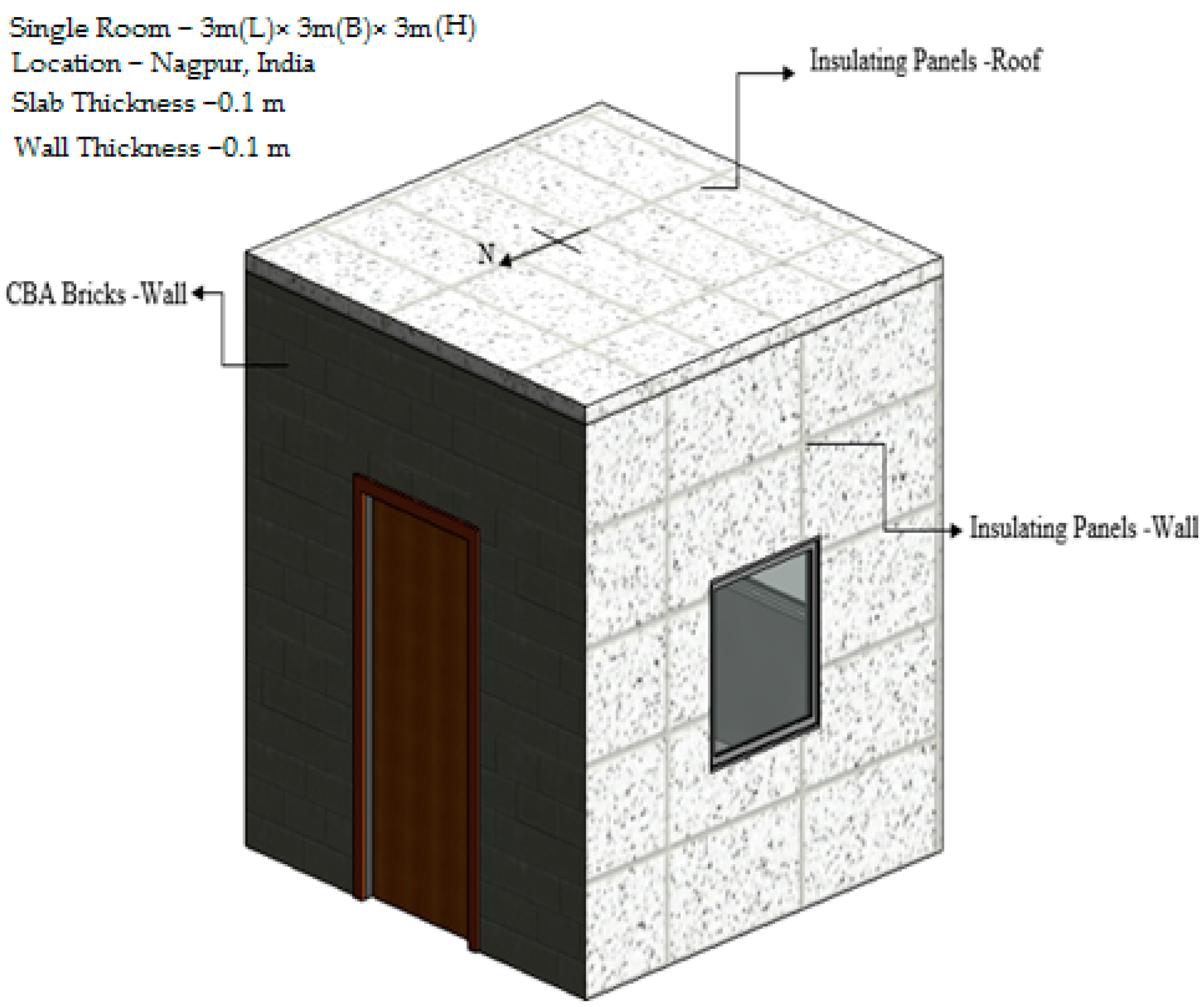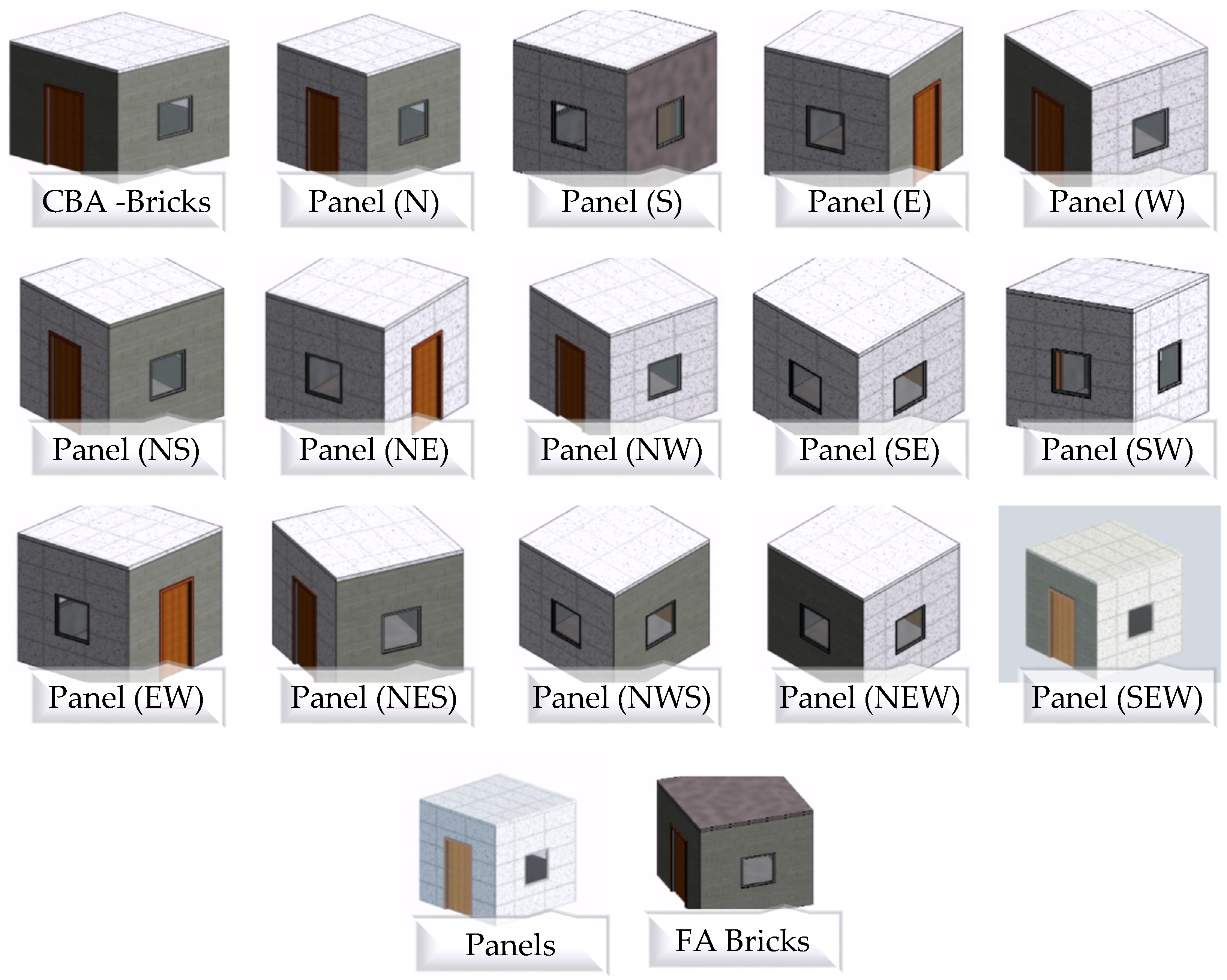1. Introduction
India is the second-most populous country in the world after China, with a population of around 1380 million and a growth rate of about 1% [
1]. The country has a population density of 464/km
2 and 35% of its population resides in urban areas. Growth of the country’s urban population compared to the total population over the past six years is shown in
Figure 1. The need for urban housing led the government to initiate the “Housing for all” scheme in 2015, under which 20 million urban houses have to be constructed by 2022. This brings to around 8000 the number of units to be constructed per day. Indian housing units were categorized into four sectors, namely economically weaker section (EWS), low income group (LIG), middle income group (MIG), and high income group (HIG). The scheme mainly focuses on providing housing for the EWS and LIG groups residing in the urban areas [
2].
Currently, the construction sector is the second largest industry in the country after agriculture. Despite the growth in industrialization and urbanization, the construction industry faces many challenges regarding delays, cost overruns, and risks involved in projects [
3]. Advancement in technology, and the requirement of efficient construction practices, have led to novel methods of construction, and prefabrication is one of them. Prefabrication, also referred to as prefab, can be defined as the manufacturing and assembly of construction components off-site in a controlled industrial environment and installation of these at the on-site location [
4].
Modern construction activities are accountable for 30% of CO
2 emissions, 32% of energy consumption, and 30–40% of waste generation globally, which creates an impact on the economy, environment, and society [
5]. According to a report submitted by the UN Climate Action summit 2019, nations have been asked to reduce their CO
2 emissions by about 45% by 2030 and reach net zero by 2050 [
6]. The environmental impact regarding the CO
2 emissions caused by major construction products such as steel, cement, and bricks, is summarized in
Table 1. Promotion of low-cost, low-energy, and sustainable techniques can help in attaining the housing targets set by the government [
7] and this was emphasized by the results of an industry focus group meeting with the Indian Concrete Institute (ICI) and industrial associates [
8].
The need for the cities to be smart, sustainable, green, and low carbon has increased the opportunities for sustainable urban growth [
15]. Sustainable infrastructure that can be adaptable to different climatic conditions is being considered for the long-term perspective [
16,
17]. Maintaining environmental sustainability in the cities that have rapid population growth is considered as one of the major challenges [
18]. Thus cometh the involvement of the materials that are conducive to this sustainability as well as climate-resilient. Poor maintenance of solid waste management can also lead to drastic changes in climatic conditions [
19]. Thus, utilization of sustainable materials such as by-products of various agro-industrial activities is being tested for their suitability in the construction sector, as their disposal is quite challenging. The inclusion of microsilica, sugarcane bagasse ash (SBA), bio-briquette ash (BBA), and co-fired blended ash (CBA) in the construction process has improved the performance of construction products [
20,
21,
22,
23,
24]. Insertion of insulation materials into construction products has also resulted in making structures energy efficient, thermal resistant, cost effective, and reduced dead loads. Typical insulating materials such as extruded polystyrene (XPS), expanded polystyrene (EPS), vacuum insulation, polyurethane foam (PUF), and polyisocyanurate (PIR) have been used for making insulated precast concrete sandwich wall panels [
25,
26,
27].
Urban housing built with conventional methods has to be constructed in densely populated areas with cost and resource constraints [
28]. Prefab technology comes with many advantages, resulting in reduced on-site construction waste, noise and dust pollution; time and cost savings; consistent quality; and better safety and resource management [
3,
5,
29]. Yet this technology has some limitations, such as the requirement of high initial investment, low market demand, site access, and lack of standard codes, designs, and expertise. According to research conducted in some case studies, prefabrication resulted in reduction of construction waste by 65% and on-site labor requirement by 16%, and time savings of 15% [
30]. The construction cost slightly increased, by 1.4% on average, but the rate of on-site accidents dropped by 63% when compared to conventional construction. However, when considering economic, environmental and social benefits, the limitations of this technology are found to be minimal and can be overcome through efficient use of resources and proper design.
As with conventional construction, costs of prefabrication have to be determined to analyze the feasibility of a project. The costs for masonry, plastering, measurement works, and labor requirements were less in comparison with on-site conventional construction [
31], whereas additional costs for prefabrication regarding manufacture, assembly, and installation—such as setting up of the precast yard, molds, controlled curing, transportation, and erection of the end products at the specified location—have to be considered. According to one study, construction of an individual double-story residential building with prefab resulted in a 21% increase in cost but a 49% decrease in duration when compared to conventional methods [
32]. The sub-structure part was found to be similar in both the cases. Prefab was found to be feasible for large-scale constructions like mass housing rather than individual buildings.
Concomitantly, in India, electricity consumption patterns across states exhibit significant inequity at the household level. Sixty percent of current space cooling energy consumption is by 10% of the population and the increasing demand for sustainable and affordable housing needs to be taken into consideration. The increasing demand for sustainable and affordable housing, the disposal of solid waste generated from agro-industrial activities, and the energy peak demand in extremely hot and cold seasons are the challenges. The Indian government launched the 20-year India Cooling Action Plan (ICAP) in March 2019 to address cooling requirements in buildings. So far buildings’ energy efficiency policies have focused largely on making cooling and heating technologies more efficient energy-wise. The enormous environmental, energy, and cost impact could be reduced by innovative building design with sustainable clean materials to improve comfort, and reduce mechanical cooling in buildings. This could be a game-changer for the way buildings are designed.
The presented literature explores the necessity of affordable and sustainable urban housing which can be constructed within a limited time interval and with quality control. Prefab housing has been found to be expensive for small-scale projects and hence the economical number of mass housing units has to be determined for any construction project to be feasible. The current study involved the development of sustainable construction products such as bricks, mortar, and concrete for slab panels which utilized industrial waste, namely co-fired blended ash (CBA). Various models were developed in the building information modeling (BIM) software, including CBA-based products with varying alignments of prefab wall panels, and the cost and energy consumption of these models were compared with those of currently available construction techniques. This research work attempts to calculate the number of prefab housing units required for economical construction.














